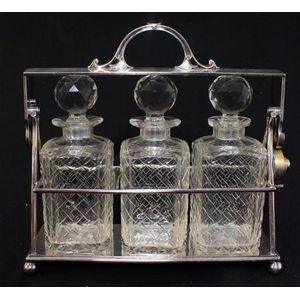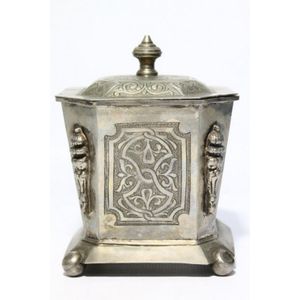Mh Sheffield Tantalus with Crystal Bottles, 1879 Registration
You must be a subscriber, and be logged in to view price and dealer details.
Subscribe Now to view actual auction price for this item
When you subscribe, you have the option of setting the currency in which to display prices to $Au, $US, $NZ or Stg.
- Tantalus - A tantalus is a container for holding two or three glass or crystal bottles of alchoholic drinks. A tantalus may take various forms, the most common being made from silver, silver plate or wood with the three bottles in a circle or two bottles in line with a central handle. A larger version has three bottles in a line with two end supports and a horizontal top and handle. To prevent unauthorised access, some tantalus have a locking mecahnism that prevents the bottles and stoppers being removed from the bottles when secured.
A box tantalus, as the name implies is an elaborate wooden box made of a fancy timber such as coramandel, with divisions for the bottles and a lockable lid. Some of these type are designed for liquers and include the liquer glasses set into fitted holders. - Registered Design - During the period 1842-1883 the Patent Office issued a diamond mark along with the registration number when a design was registered.
Besides indicating that the design had been registered, a diamond mark offered the buyer the reassurance of knowing an item was of British design. It assured the person registering the design a degree of protection from copying.
The mark was created to identify the type of material used (known as the class), how many items were included, (sometimes known as bundles or packages), and the date of registration.
On the diamond mark the year of registration is shown along with the month code. However, there are two ranges of year codes; 1842-1867 and 1868-1883. By looking at the design of the diamond mark you should be able to determine the correct year from the design of the diamond mark and the placing of the day number.
Source and further information: http://www.nationalarchives.gov.uk/records/research-guides/reg-design-diamond.htm
This item has been included into following indexes:
Visually similar items

An Edwardian Sheraton Revival three bottle tantalus, the mahogany frame with satinwood fan inlays, silver plate top section, lock and handle, unlocking and swivelling to release the three square section decanters with cushion cut detail and faceted ball st

A James Dixon & Sons silver-plate three-bottle tantalus, chips to the rim of one bottle, and chips to the bottom of each stopper

A lidded silver tea caddy, 20 x 14 cm

A silver plated tantalus with set of three matching crystal decanters, English 19th century. 33 cm high
